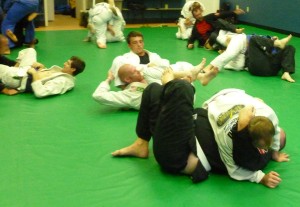
Brazilian Jiu Jitsu is a lifetime journey. It’s a marathon, not a sprint. You can never hope to learn every single nuance of every movement in BJJ, because not only are there countless individual techniques, but there are also new moves being invented literally every single day, all across the world.
For now, let’s focus on how to learn one individual technique. It doesn’t matter if it’s a basic armlock from the guard, a tricky lapel choke, or a berimbolo rolling back take. The concepts of internalizing a BJJ technique are as follows:
Stages of learning
1. Being shown a technique
Obviously, in order to learn how to do a new technique, you have to be presented the information in the first place. Nevertheless, there are other ways in which a technique can be added (like true innovation due to creativity, or simply by stumbling onto something awesome while rolling, which does happen), but let’s focus on the most common: learning by seeing someone else do it.
2. Going through the basic motions of the technique with a partner
This is the phase of technique where people start to feel like they understand the way a move works. It is integral to completely “owning” a technique, but it’s certainly not the end of the road, contrary to what some might think. That being said, this is where your body begins to learn what your mind has just been presented. The mind-body connection is crucial with new techniques, and the door opens when you begin doing a move in class (or outside of class) with a live partner.
3. Getting corrections on said technique
Here, the learning you get at the gym is going to diverge strongly from that which you get from Youtube, from books and magazines, or by simply watching others do the move and then trying to replicate it with a partner at your home. A good instructor is priceless, because they’ll quickly be able to analyze the position you’re working on and give you feedback. Many instructors will preemptively troubleshoot problems when showing the move the first time (“don’t do it like this, but do it like this”), but there are always going to be subtle improvements to be made while going through the movements. “Practice doesn’t make perfect; perfect practice makes perfect,” as the old adage goes.
4. Drilling with many repetitions
Contrary to popular belief, this is not the same as step #2. Having said that, most grapplers tend to neglect this step. It’s difficult to accomplish this step because (at many gyms) there simply isn’t time allotted for repetition on techniques for the proper amount of time for the move to sink in. Therefore, this step takes not only discipline, but (in many cases) personal time outside of class, or at open mat. The temptation to roll at open mat instead of drill is very, very high, but you will often be better served to see if you can do 10 minutes of armbars from the guard (EG) instead of rolling for two rounds.
5. Pulling it off on a live opponent
Here is where the theoretical becomes the experimental, and where BJJ separates itself from many other martial arts. You actually have to execute this move against a resisting opponent before you really understand it, and that can be pretty tough. You can drill with repetition, but miss a certain key detail that is invisible even to your instructor. You may not know what detail you’re missing until your partner shuts you down. That kind of real-time feedback is priceless, and that’s why you absolutely must roll in order to fully understand the technique.
A sixth step would be making the technique your own, which includes finding your own entry into the position that works well with your existing game, or figuring out a simple variation that works better for your body type. This step isn’t absolutely required so that you understand the technique, so it’s optional, but if you can make the technique your own, your learning will certainly be more complete.
Remember that jiu jitsu is, indeed, a lifetime journey. You may not gather all five (or six) components of understanding in a single day, or even in a single week. I’ve certainly been shown a technique one year, and then five (or ten, or sometimes more) years later, I have finally internalized the understanding of the technique. However, making the time to ensure that you follow these steps can help expedite your understanding.